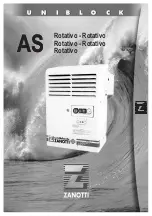
23
9.
Inspect the burners and clean them (if necessary)
with a soft wire brush and/or the nozzle of a vacuum
cleaner.
BE EXTREMELY CAREFUL NOT TO
DAMAGE THE IGNITOR WHILE CLEANING THE
BURNER.
10. Replace all the parts in reverse order from which
they were removed.
11. Follow the lighting instructions found on the lower
unit door to return the unit to operation.
CAUTION:
Verify proper operation after servicing.
Operating Sequence
The operating sequences for the heating, cooling, and fan
modes are described below. Refer to the wiring diagram
for the unit
(Figure 10)
.
Cooling Mode:
1.
On a call for cooling the thermostat closes, applying
24 VAC to the green and yellow leads in the low
voltage area.
2.
The green lead applies 24VAC to the “G” terminal of
the integrated control energizing the main circulating
blower circuit at the cooling speed.
3.
The yellow lead applies 24VAC to the contactor.
4.
When the thermostat is satisfi ed the contactor and
integrated control are de-energized.
5.
The circulating blower motor is de-energized after
a 90-second delay.
Blower Mode:
1. On a call for fan only operation, the thermostat
applies 24 VAC to the green lead connected to the
“G” terminal of the integrated control.
2. The circulating blower is energized immediately
at the heating speed if “2-SPD” is selected on
the control or the fan only speed if “3-SPD” is
selected.
3.
If a call for heat occurs, the circulating blower de-
energizes prior to normal heating cycle.
Heating Mode:
1. On a call for heat the thermostat closes, applying
24 VAC to the W terminal on the control board.
2. The control board checks for continuity on the 24
VAC limit control circuit (over-temperature limit
switch, fl ame rollout switches and blocked vent
switch in series). If an open limit is detected the
control board will energize the inducer blower. All
other system functions will be inoperable until the
limit circuit closes. While the limit is open, the red
LED will pulse at a rate of 1 blink per unit time.
3.
The furnace control checks for continuity across the
pressure switch (24 VAC). If the pressure switch is
closed the heat mode sequence will not continue.
If it remains closed for 10 seconds the red LED will
blink 3 times repetitively until the fault condition
clears.
4.
If the pressure switch is open, the inducer is ener-
gized.
5.
The pressure switch will close. If the pressure switch
does not close after 10 seconds the fault LED will
blink 2 times repetitively and the inducer will continue
to run until the switch is closed.
6.
The inducer will pre-purge for 30 seconds and then
the igniter will start its warm-up as follows:
Initial Power up: After 30 seconds of igniter warm-up
the gas valves (24 VAC) will then opn. The igniter
circuit will stay energized for 3 seconds after the
gas valve opens.
After Initial Power up: The control has a programmed
adaptive ignition feature which varies the warm-up
period as follows: If ignition is successful the warm-
up is reduced by 3-seconds on each subsequent
call for heat until ignition failure occurs. Upon ignition
failure, the warm-up is increased by 3-seconds on
the next try. If successful, the timing remains fi xed
at this level. In general, whenever ignition failure oc-
curs the warm-up interval is increased by 3-seconds
on the next try. And if successful, it remains there.
Min. and max. warm-up time limits are set at 6 and
54-seconds, respectively.
7. The furnace control must prove fl ame via the
fl ame sensor 5 seconds after the gas valves open.
If fl ame is sensed, burners are on and the igniter
cools off. If no fl ame is sensed, the gas valve closes
immediately and the inducer continues to run. A
second trial for ignition (step 6) begins. If no fl ame
is sensed on the fi fth try for ignition, the furnace
control is locked and the red LED will blink 4 times
repetitively. The thermostat must be opened for at
least ten seconds to reset the furnace control after a
lock out. Otherwise, the furnace will attempt another
ignition sequence in 1 hour.






















